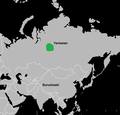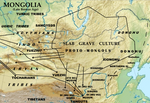The Karasuk culture (Russian: Карасукская культура, romanized: Karasukskaya kul'tura) describes a group of late Bronze Age societies who ranged from the...
30 KB (3,264 words) - 12:19, 22 January 2024
Karasuk may refer to: Karasuk culture, a group of Bronze Age societies Karasuk languages, a hypothetical language family linking the Yeniseian languages...
520 bytes (92 words) - 19:20, 4 June 2020
possibly proto-Scythian. The Deer stones culture seems to have been influenced by the contemporary Karasuk culture to the northwest, with which it shares...
81 KB (9,910 words) - 03:36, 10 July 2024
languages. The name Karasuk was proposed by George van Driem of the University of Leiden. The family is named after the Karasuk culture, which existed in...
6 KB (535 words) - 01:45, 9 June 2024
Eurasia. The Tagar culture was preceded by the Karasuk culture. They are usually considered as descendants of the Andronovo culture, and are frequently...
20 KB (1,924 words) - 01:17, 21 April 2024
weapons discovered in the tomb are quite similar to those of the late Karasuk culture. These early objects suggest a datation to circa 800 BCE (late 9th...
35 KB (3,929 words) - 01:18, 21 April 2024
The Lusatian culture existed in the later Bronze Age and early Iron Age (1300–500 BC) in most of what is now Poland and parts of the Czech Republic, Slovakia...
13 KB (1,261 words) - 21:05, 3 July 2024
67°38′42″E / 53.303°N 67.645°E / 53.303; 67.645 The Botai culture is an archaeological culture (c. 3700–3100 BC) of prehistoric northern Central Asia. It...
23 KB (2,196 words) - 15:52, 7 July 2024
knives Seima-Turbino knives, Tallgren 1938 Andronovo culture Sintashta culture Karasuk culture Bjørn, Rasmus G. (January 2022). "Indo-European loanwords...
27 KB (2,864 words) - 20:28, 20 June 2024
Cycladic culture (also known as Cycladic civilisation or, chronologically, as Cycladic chronology) was a Bronze Age culture (c. 3100–c. 1000 BC) found...
14 KB (1,538 words) - 13:54, 29 April 2024
The culture was discovered, first excavated, and published in the 1930s–1940s by M.P. Gryaznov, who took it for a local version of the Karasuk culture. In...
14 KB (1,463 words) - 03:30, 16 May 2024
directions, in the beginning of 1st millennium BCE from south from the Karasuk culture, and later in the 1st millennium BCE of northern tribes notable for...
8 KB (660 words) - 09:53, 31 December 2023
Andronovo culture was succeeded by the Karasuk culture (1500–800 BC). On its western border, it is roughly contemporaneous with the Srubna culture, which...
63 KB (7,042 words) - 16:33, 22 May 2024
being reused in the mid-first millennium AD JETTMAR, KARL (1950). "THE KARASUK CULTURE AND ITS SOUTH-EASTERN AFFINITIES" (PDF). Bulletin of the Museum of...
54 KB (5,766 words) - 06:21, 23 May 2024
The Ulaanzuukh culture, also Ulaanzuukh-Tevsh culture (Ch:乌兰朱和文化, c. 1450-1000 BCE), is an archaeological culture of the Late Bronze Age eastern Mongolia...
11 KB (1,186 words) - 09:55, 23 June 2024
Timber-grave culture, was a Late Bronze Age 1900–1200 BC culture in the eastern part of the Pontic–Caspian steppe. It is a successor of the Yamna culture, the...
16 KB (1,622 words) - 21:21, 22 March 2024
The Hallstatt culture was the predominant Western and Central European archaeological culture of the Late Bronze Age (Hallstatt A, Hallstatt B) from the...
77 KB (8,507 words) - 04:56, 7 July 2024
Kurgan hypothesis (redirect from Kurgan culture)
prehistoric cultures, including the Yamnaya (or Pit Grave) culture and its predecessors. In the 2000s, David Anthony instead used the core Yamnaya culture and...
34 KB (3,825 words) - 11:30, 3 July 2024
The Urnfield culture (c. 1300–750 BC) was a late Bronze Age culture of Central Europe, often divided into several local cultures within a broader Urnfield...
99 KB (10,748 words) - 04:54, 28 June 2024
Minoan civilization (redirect from Minoan culture)
The Minoan civilization was a Bronze Age culture which was centered on the island of Crete. Known for its monumental architecture and energetic art, it...
116 KB (13,771 words) - 00:06, 6 July 2024
Cimmerians (redirect from Kimmerian culture)
Asian origin, a strong material influence from the Altai, Aržan and Karasuk cultures from Central Asia and Siberia is visible in the Chernogorovka-Novocherkassk...
142 KB (17,044 words) - 14:21, 2 July 2024
Abashevo Culture Catacomb Culture Sintashta Arkaim Petrovka settlement Country of Towns Multi-cordoned ware culture Cimmerians Karasuk culture Andronovo...
46 KB (4,864 words) - 19:21, 20 June 2024
The Únětice culture, Aunjetitz culture or Unetician culture (Czech: Únětická kultura, German: Aunjetitzer Kultur, Polish: Kultura unietycka, Slovak: Únětická...
77 KB (8,228 words) - 11:05, 18 June 2024
The slab-grave culture art has many common features with cultures of Southern Siberia: Karasuk, Tagar, and others. Thousands of graves can now be seen...
32 KB (3,948 words) - 09:44, 23 June 2024
Maykop culture (Russian: майкоп, [mɐjˈkop], scientific transliteration: Majkop,), c. 3700 BC–3000 BC, is a major Bronze Age archaeological culture in the...
22 KB (2,645 words) - 16:38, 29 June 2024
Indus Valley Civilisation (redirect from Indus Valley Culture)
and later cultures called Early Harappan and Late Harappan in the same area. The early Harappan cultures were populated from Neolithic cultures, the earliest...
187 KB (21,263 words) - 06:37, 6 July 2024
Catacomb culture. In addition to the Yamnaya culture, the Catacomb culture displays links with the earlier Sredny Stog culture, the Afanasievo culture and...
28 KB (3,366 words) - 16:37, 29 June 2024
The Tumulus culture (German: Hügelgräberkultur) was the dominant material culture in Central Europe during the Middle Bronze Age (c. 1600 to 1300 BC)...
23 KB (2,064 words) - 10:43, 1 July 2024
The Belozerka culture or Belozerskaya culture was a Late Bronze Age archaeological culture of the later (12th–10th centuries BCE) which replaced the Srubnaya...
2 KB (167 words) - 08:01, 31 January 2024
the Pazyryk-2 chief. Aldy-Bel culture Bulan-Koba culture Karasuk culture Pazyryk burials Tagar culture Tashtyk culture Scythians The Editors (11 September...
21 KB (2,039 words) - 01:15, 21 April 2024
























